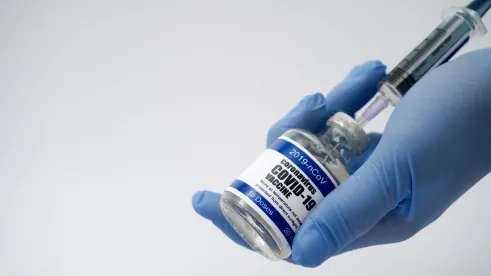Very soon, perhaps within weeks, senior leadership at law firms and bar associations are going to be confronted by a dramatic change in the way they are currently managing their office response to COVID-19. Partners, associates, paralegals and other employees will first look to federal, state and local medical authorities for guidance about a vaccine to prevent COVID-19. Legal leadership will have to quickly sort truth from fiction and learn at least the rudiments of epidemiology. The article below, written by a crisis communications specialist, puts all of this in context, along with offering practical suggestions.
The next pandemic-related surge is about to confront us all. It’ll be a surge of lies, misinformation and disinformation about the imminent COVID-19 vaccine. Expect it to come at us in warp speed over the coming days and weeks.
On November 9, Pfizer and its German partner, BioNTech, announced that the vaccine they’ve developed and tested in phase 3 clinical trials is more than 90% effective protecting people from COVID-19 infection. Bottom line: For every 100 people injected with the vaccine, 90 will not get the infection. With fast-track FDA approval, tens of millions of doses could be available before the year ends.
With one out of five Americans already saying they won’t take the vaccine, the communication challenge for the U.S. government and the health care community is a monumental one. Public health officials have called it “a train wreck waiting to happen.”
The Centers for Disease Control and Prevention (CDC), always the country’s go-to source for health crisis information, was minimized by the administration – its voice subsumed by the new government task force Operation Warp Speed and the Department of Health and Human Services (HHS). The outgoing administration continues to politicize the issue:
-
Mixed messages from the administration that masks are not needed, that COVID-19 is no worse than the flu and that infection and death rates are inflated clash with its own Operation Warp Speed program created to buy and distribute hundreds of millions of doses of the vaccine to Americans.
-
The Pfizer announcement was quickly met by the president’s son with a conspiracy tweet alleging the timing of the news – one week after the election – may’ve been purposeful and “nefarious.”
-
At the same time, the vice president extolled the announcement, giving Warp Speed credit for the vaccine’s development despite the fact the vaccine was bankrolled with $445 million from the German government, not the U.S.
Anti-vaxxers and conspiracy theorists continue finding ways to communicate doubt and falsehoods on social media platforms, although Facebook, Twitter and YouTube have beefed up their policies about posting misinformation. Social media algorithms keep pushing zealot views to like-minded followers, confirming their beliefs. And since multiple pharma players – including Pfizer/BioNTech, Moderna, Johnson & Johnson and AstraZeneca – are each developing their own vaccines, additional misinformation risks loom.
In a perfect world, U.S., state and local governments, pharma companies and health care organizations should speak with one voice in an aggressive, proactive, ongoing public health information campaign to educate the American public about the vaccine. Designate a lead organization and speak about the vaccine across all communication platforms – including the media – every day. Explain how vaccines are developed. How the vaccine developers were able to speed up their breakthroughs without compromising patient safety. How the vaccine will be made available and the order of people who will receive it. Explain the vaccine’s efficacy and risks honestly. Recruit spokesperson ambassadors from entertainment, sports, academia, religious and community organizations to help spread the word. Then explain it all again.
Messaging must be consistent transparent and truthful. Messaging can’t pivot on “get the vaccine and voila! Everyone’s life is back to normal!” The Pfizer flavor of the vaccine sounds like it’ll hurt and it’ll initially make you feel sick. Dr. William Schaffner, a vaccine expert and professor of infectious diseases at Vanderbilt University, told USA Today, “This is a nasty vaccine to get. It really makes your arm sore. It can make you feel crummy for 24 hours. And remember, it’s a two-dose vaccine. Well, guess what – the second dose is worse than the first.”
Can you expect to win everyone over with a pervasive public health information campaign? No. A third of the campaign’s audience will buy into it, a third will be on the fence, and a third will continue to be outraged. Noted risk management expert Peter Sandman writes that the most coordinated communication effort may not change the minds of angry or frightened people, but you should work to find middle ground:
-
Acknowledge opponents and their concerns. Listen carefully to them and find points of agreement. Stress those points in future outreach.
-
Acknowledge mistakes. The CDC’s early errant advice that face masks were unnecessary, for example. “The prerogative of deciding when you can put your mistakes behind you belongs to your stakeholders, not to you,” says Sandman. “The more often and apologetically you acknowledge the sins of the past, the more quickly others decide it’s time to move on.”
-
Acknowledge problems and be accountable. Multiple vaccines from multiple pharma manufacturers and distribution challenges will likely be issues. There will be other unforeseen issues as well. Acknowledging problems – even those you haven’t yet solved – builds credibility and transparency.
Backlash against vaccines in the U.S. is almost as old as the country itself, from opposition to smallpox vaccines in the 19th century to controversy over tuberculosis, polio, DPT MMR and HPV vaccines in more recent times. Supercharged by the megaphone social media provides, those opposed to or confused by a COVID-19 vaccine pose a formidable challenge that law firm and bar association leadership, as well as communicators in virtually every industry sector must meet head-on.




 />i
/>i
